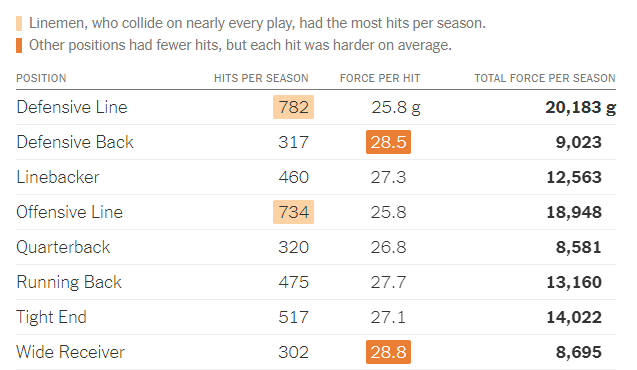The Largest Study of Chronic Traumatic Encephalopathy Sheds Light on the Impact of Head Hits in Football
 Collective Force of Head Hits and High Impact Workloads Increase Odds of C.T.E.
Collective Force of Head Hits and High Impact Workloads Increase Odds of C.T.E.
Football has long been associated with injuries, including concussions and their long-term effects on players’ cognitive health. A groundbreaking study published in the scientific journal Nature Communications has revealed important insights into chronic traumatic encephalopathy (CTE), a degenerative brain disease often found in athletes with a history of repetitive head impacts. This study, the largest of its kind to date, highlights the relationship between the cumulative force of head hits and the development of CTE. Additionally, it brings attention to an alternative approach to tackling this issue by considering Athlete Intelligence as a solution.
The Impact of Head Hits:
The study, overseen by researchers at Boston University, analyzed data from 34 studies that tracked the number and magnitude of head hits using football helmet sensors. By estimating the cumulative force of head impacts absorbed by 631 former football players, the researchers identified a crucial factor contributing to CTE: the cumulative impact of head hits over a player’s career. Contrary to popular belief, the study found that the number of diagnosed concussions was not the best predictor of brain disease later in life. Instead, the cumulative force of head hits emerged as the most significant factor. This suggests eliminating repetitive head contact is critical.
CTE and Its Consequences:
Chronic traumatic encephalopathy is a neurodegenerative disease associated with cognitive decline and various neurological symptoms, such as memory loss, depression, impulsive behavior, and even suicidal thoughts. Of the 631 brains examined in the study, 71 percent showed evidence of CTE. Notably, the players who had absorbed the highest cumulative force of head hits exhibited the most severe forms of the disease.
Changing the Approach to Player Safety:
The study’s findings emphasize the importance of addressing the cumulative impact of head hits rather than focusing solely on concussions. This shift in perspective has led to a growing movement in football towards reducing the number of hits players experience. One example is the approach adopted by Jeffrey Vlk, the coach at Buffalo Grove High School. Recognizing the risks associated with full-contact practices, Vlk eliminated such practices, opting for less intense contact days and observing a significant decrease in injuries among his players.
Which high school players get hit most? Get hit the hardest?
This table shows the number of head hits and the average force of impacts experienced by high school football players, according to the results of the study. The researchers used tables like this to estimate a player’s lifetime exposure to head hits based on the positions they played at each level.

The Role of Athlete Intelligence:
To further enhance player safety, an emerging solution worth exploring is Athlete Intelligence. By leveraging advanced technologies and data analytics, Athlete Intelligence platforms can provide real-time insights into player performance, monitor impacts, and help identify potential risks associated with head hits. These platforms offer a proactive approach to safeguarding players by tracking their cumulative force of head impacts and alerting coaches and medical staff when certain thresholds are exceeded. By taking a data-driven approach to player safety, Athlete Intelligence technologies can complement efforts to reduce the risk of CTE.
Future Considerations:
While this study represents a crucial step forward in understanding the causes and prevention of CTE, it also highlights the need for further research. Future studies should explore different thresholds for counting head hits to determine which impacts are most damaging. Understanding the nuances of head impacts will aid in developing targeted interventions to minimize the risk of long-term cognitive problems.
The largest study of chronic traumatic encephalopathy to date has shed new light on the relationship between head hits and the development of CTE. By focusing on the cumulative force of head impacts, researchers have identified a critical factor in determining the risk of brain disease later in life. To address this issue, the football community is adopting strategies that reduce the number of hits players experience, such as eliminating full-contact practices. Moreover, Athlete Intelligence platforms offer a promising solution.
About Athlete Intelligence
The Athlete Intelligence system is an innovative way of tracking head impacts, which can help reduce the risk of injury. The system allows for real-time alerts and helps improve athlete performance. The data generated by the system helps identify patterns in head impacts and shows the effectiveness of proper tackling techniques. Reports and analytics provide coaches with valuable information on their athletes, allowing them to make informed decisions and adjust training accordingly.